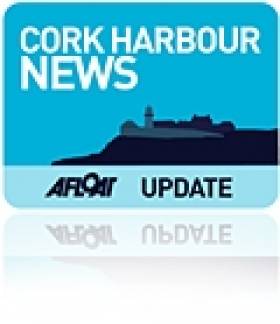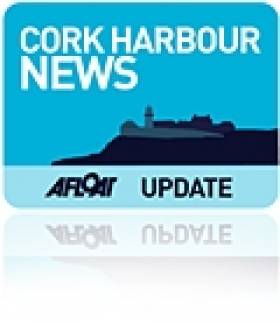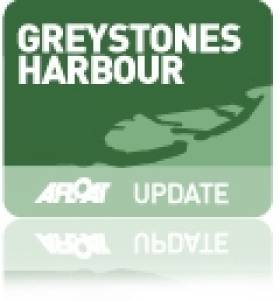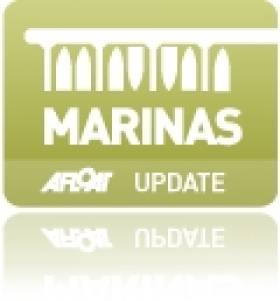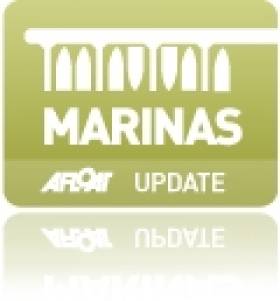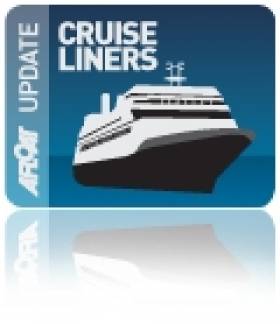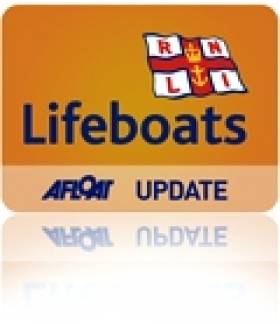Displaying items by tag: Harbour
Dun Laoghaire Harbour Seeks 'Creative Director'
#JOBS – Dun Laoghaire Harbour Company is seeking to recruit a 'Creative Director' for its 'Diaspora Centre' which is due to be built on the Carlisle Pier as part of the harbour's redevelopment.
The new diaspora centre will rival the likes of Sydney Opera House, according to the semi-state body behind the proposal.
Dun Laoghaire Harbour Company estimates the cost of the project at €50 million. Most of this will come from EU and State funding, but some €15 million in donations will be required for the scheme to go ahead.
The Creative Director job spec reads; 'the person will have the quality, experience, ability, vision and energy to lead the Project Team to deliver a best-in-class project plan for this Landmark cultural attraction on the historic Carlisle Pier in Dun Laoghaire Harbour'.
To download the 'Creative Director' job description and how to apply for the (initially one year) position click here
Marine Notice on Construction in Castletownbere Harbour
#IRISH HARBOURS - The latest Marine Notice from the Department of Transport, Tourism and Sport (DTTAS) advises on construction works at Castletownbere Fishery Harbour Centre in Co Cork this week.
The works involve the installation of four steel piles - two in the navigation channel to the inner harbour and two to the west of Dinish Pier.
The works are being advanced by civil engineering crews working from a jack-up barge, which will display the relevant day signals and navigation lights in accordance with collision regulations.
For safety reasons, mariners are requested to proceed slowly and with caution in the approach channel to the Fishery Harbour Centre and to give the works a wide berth. Wave-wash from vessels should also be avoided.
These works are expected to be on-going until mid-December, weather permitting.
Complete details for shipowners, ship operations, shipmasters and seafarers are included in Marine Notice No 57 of 2011, a PDF of which is available to read and download HERE.
900 Brazilian Delegates Come to Cork
Cork Convention Bureau (CCB) has been working with Kuoni on an impressive itinerary for next year. A group of 12 visited Cork on September 17th and 18th last on a fact finding mission. CCB ensured they experienced the best of the region including a visit to the coastal town of Kinsale, the Queenstown Heritage Centre in Cobh, Fota House and even a night at the dog races! As a result of this site inspection a programme has been devised. A gala dinner in the grounds of Castlemartyr Resort Hotel with the backdrop of the castle ruins has been proposed followed by a day of excursions including the Jameson Distillery in the town of Midleton and the obligatory kissing of the Blarney Stone. Two hours of free time in Cork's city centre will allow the group to browse the chic boutiques and have lunch at many of Cork's great restaurants tasting local artisan produce.
'This business will be worth an estimated €500,000 to the Cork region. Since its inception in 2007, CCB has been responsible for more than €20 million worth of conference, meeting and incentive business in Cork. Cork is at its peak right now and international event organisers looking for new destinations are very impressed with the product offering.' Evelyn O'Sullivan, Business Tourism Manager CCB. (Cork Convention Bureau is an initiative of Cork City and County Councils, Failte Ireland and is also supported by the regions hotels.)
Commenting on the delegate visit to Cork, Captain Michael McCarthy Port of Cork said: "This is a fantastic opportunity for Cork to leave a very positive welcoming experience for the 900 visitors. It is very encouraging to see commercial companies using the cruise liner business as a method of visiting the region. Statistics available from the cruise lines indicate that 30% of cruise passengers make a return visit to a region they visited on their cruise itinerary. This would be excellent for Cork if some or all of these delegates return in the future with their family or friends or indeed looked at future business opportunities." In order to ensure that their visit is memorable, the Port of Cork will coordinate a special welcome with the Tour Operator, Cobh Tourism, Town Council and Chamber, Irish Rail and Cork City TEAM.
He continued: "The Port of Cork has been involved for the last 3 years with Spanish, French and Portuguese Ports in developing the European Atlantic Area as a premier cruise destination. This work under an EU Initiative "Cruise Atlantic Europe" is aimed at developing the historic links between these countries and the Latin nations in South America, particularly Brazil to encourage them to visit this region. The Independence of the Seas is due to berth in the Port of Cork between the 6th-7th May 2012 with over 5,000 passengers and crew.
Cove Salute Media Couple for 'Contribution to Sailing'
#CORKSAILING – Cove Sailing Club's annual prizegiving hosted by Commodore Derry Allister was held with a certain vibrancy at the weekend. Members are buoyed up with the news that its new Junior section at Whitepoint has recruited 152 members, a great boost to sailing in Cork Harbour. The Cobh club is pressing ahead too on its own marina plans, another big area of progress for marine leisure berthing in the harbour.
Earlier this year Cove Sailing Club was granted full planning permission for a 74 berth marina (including visitor berths) at Whitepoint. The proposal being developed is that Cove Sailing Club shall develop and manage the marina in order to provide facilities for use by club members and visitors to Cove.
This year's laying up supper was held at the Commodore Hotel in the seaside town. Members met in the downstairs bar before heading for the Jack Doyle room for lay-up dinner and prizegiving.
There were plenty of annual prize winners from the season of club events (SEE PHOTOS BELOW). Sailing Correspondent and Photographer Claire and Bob Bateman of this Parish received special mention for their work in promoting sailing in the harbour.
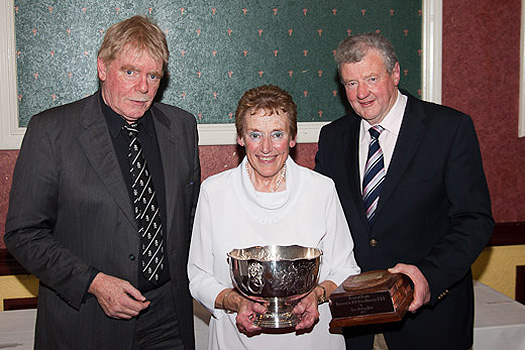
Cove Sailing Club Commodore Derry Allister (left) presents Sailing Journalist's Claire and Bob Bateman with the Foley Rose Bowl
The Bateman's were presented with the Foley Rose Bowl trophy. The trophy was first presented to Cove Sailing Club in 1974 when the late Bryan Foley was Chairman of the Cork Harbour Commissioners. It has many illustrious names on it and is awarded on merit, to the class, club, boat, person or group who have in the opinion of Cove Sailing Club contributed significantly to the promotion of sailing in Cork Harbour.
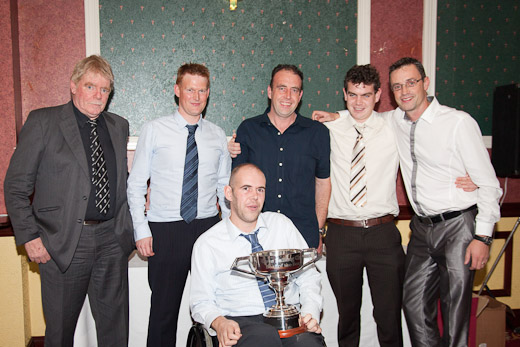
Boat of the year No Half Measures - Finbarr Dorgan (with trophy) and with Derry Allister crew (L-R)Kieran and Gareth Dorgan, Hal Courtney andRichard Marshall. They also won the overall Friday Night League for Kites IRC division.
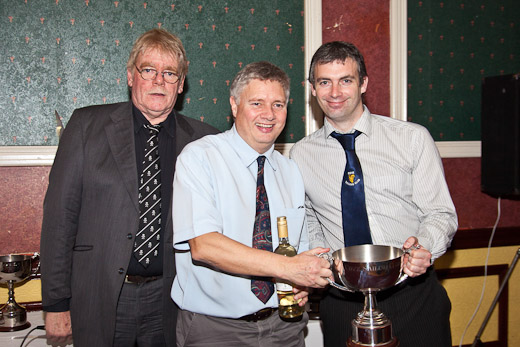
Damian Aherne, skipper of Re Eile being presented with the September league IRC trophy for class 3. Derry and Brendan Ryan (Sailing Secretary) in
background
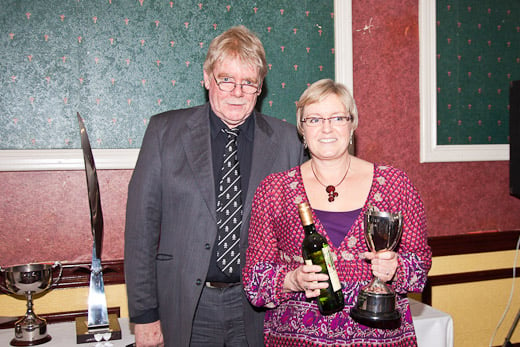
Ann Aherne being presented with the September League Echo trophy for class 3
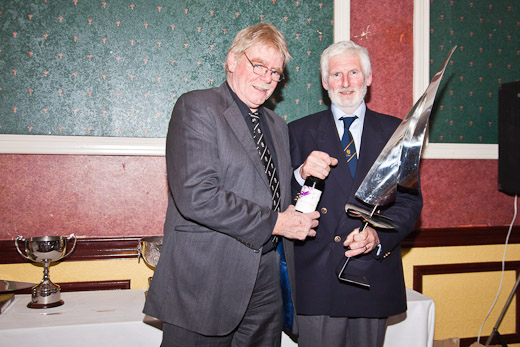
John Doyle, Chanteuse presented with the Friday Night League Whitesail trophy
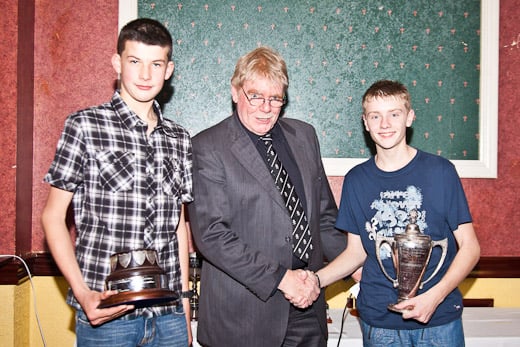
Dave Marshall and Rob Scandrett receiving the Ballinacurra Cup

Club Person of the year Brendan Ryan (Sailing Secretary)
Recognising Cork Harbour's Major Asset, Its Coastline
The Marine Leisure Infrastructure Strategy for South Cork, 2010-2020 is a document that has paved the way for additional marine leisure facilties to get established in the harbour namely the recently installed Cork Harbour marina at Monkstown.
Councillor Kevin Murphy said that, following completion of the Marine Leisure Strategy for South Cork, survey information on marine leisure infrastructure and activities is now available for the entire coastline of Cork. In 2008 Cork County Council and the Coastal and Marine Research Centre (CMRC), UCC, produced A Marine Leisure Infrastructure Strategy for West Cork, covering the coast from the Kerry border to Courtmacsherry (700km). In 2010, they completed the picture, with the South Cork Strategy covering another 500km of coastal inlets, bays, beaches and harbours, from Timoleague to Youghal. This involved auditing the coastal infrastructure and assessing the current offering in relation to tourism and leisure. As a result, Cork is uniquely placed to take advantage of the marine leisure opportunities offered by its coast.
There is an extensive legacy of marine infrastructure all along the coast of Ireland, from the heyday of the 20th century fishing industry. The 21st century brought a change in how much of this marine infrastructure was used, so that in certain areas it became less critical to livelihoods. The motive behind the 2008 Strategy was to use these resources, re-assess their value and tap into the potential of marine infrastructure to develop sustainable products, services and jobs, as well as encourage investment along the coast.
Preparatory research for the Marine Leisure Infrastructure Strategy for the Southern Division of Cork County Council included asking over 100 stakeholder organisations to submit suggestions on the future development of marine infrastructure and recreation on the South Cork coast. The responses from people directly involved in marine leisure and tourism at local level have informed the development of this Strategy, and will help promote future use of Cork's coast as part of a sustainable tourism product.
The Marine Leisure Strategy is an Action Plan for the coast, developed with inputs from these stakeholder organisations and a Steering Group with representatives from Cork County Council, CMRC, Fáilte Ireland, the ports of Kinsale, Cork and Youghal, the Town Councils of Kinsale, Cobh and Youghal, funding partnership groups (South and East Cork Area Development and West Cork Development Partnership) and Inland Fisheries Ireland. It identifies the untapped potential of the coast, contains extensive information on marine leisure activities and infrastructure, and outlines the next steps key to creating a top class coastal tourism and leisure product for County Cork.
Draft Cork Harbour Study
The Draft Cork Harbour Study looks at the most intensively used part of the South Cork coastline, on a broader and longer term basis, which includes the other activities on Cork Harbour as well as marine leisure, and looks forward up to the middle of the 21st century.
Cork harbour is one of the largest in the world, but the range, scale and importance of its functions is also exceptional - as a major port, as the setting for Cork City, most of its satellite towns and the main energy and pharmaceutical industry clusters in the State, as an over-wintering site for birds area, as a centre for boating and fishing, and as the country's main naval base, both currently and historically, with the historical aspect represented by an exceptional coastal defence heritage. All of this happens in a Harbour in which agriculture and forestry still account for more than half the land within O.5 kilometres of the shoreline.
However, this balance will not maintain itself. The proportion of land adjoining the Harbour which was developed rose from around one ninth in the 1930s to around one third now, and on a trend basis will be around two-thirds in the 2050s. This trend is not sustainable in the longer term, and the Draft Study seeks a shift in approach. More development can occur on disused or underused Harbour side industrial land, for port uses and dockland type re-development, and perhaps also for new industries such as wave power devices, which may be a thousand tons each, and need to be built beside deep water and launched like a ship. Greenfield land adjoining the Harbour should not be developed for uses that have no strong reason for being there. In practice, a balance between the development and amenity roles of the Harbour is only likely to be maintained if there is public support for this. Greater use and better public access to its amenities and recreational facilities will make this more likely.
The Study tries to understand what is happening in Cork Harbour and where it might lead, partly through analysis of around 60 shoreline areas. It is often clearest at this level how different activities interact with the inherited landscape and each other, where potentially dynamic activities offer new opportunities, and where there are tensions to be resolved. Characteristic features of Cork Harbour - such as the position of many settlements on steep slopes with their centres on narrow level areas between the base of the hill and the sea, and the concentration of transport corridors close to the shoreline - become obvious as they recur in numerous local areas
As well as having numerous different activities, Cork Harbour also has numerous organisations involved in its management and development - public, private and community based. There is growing recognition of the importance of an integrated approach to coastal areas, and Cork County Council has been a partner with other local organisations in the COREPOINT and IMCORE projects (supported by the EU INTERREG programme), and is represented on the Cork Harbour Management Focus Group. A general framework to support a more integrated approach thus already exists.
However, the Harbour will change as a result of specific choices made in particular places, and the ultimate test of an integrated approach is whether it has practical influence at that level. Cork County Council has produced a Draft Study outlining possibilities, not a Plan saying what should definitely happen next, to promote discussion of options, in the hope that a greater degree of consensus will emerge at this more practical level.
The County Manager said that it was important that Harbour residents, businesses, community and recreational groups are part of these discussions, as well as public agencies with a responsibility in the Harbour area. The Draft Study will be on public display until 15th July, in Libraries and Council Offices, and under Planning on the Council's website. Cork County Council would welcome comments from all concerned during the next seven weeks.
All our latest Cork Harbour updates here
Interim Harbour Opens at Greystones
#MARINA– Greystones Harbour developer is considering whether there is enough demand to open the planned Greystones marina next Summer following the opening of the interim harbour to the public last Saturday (November 5th).
Initial marina plans focussed on the installation of a 200-berth facility but subsequent market research cast doubt on whether the marina could be filled in the downturn. The research also showed that 80% of the berths required would be less than eight metres.
The new interim harbour consists of two public slipways, also beach launching facilities, boat compounds for the Sea Scouts, Rowers, Divers, Sailors and Anglers. The South Harbour Wall and the beach are now available for walking, opening it up for all to use according to Cllr. Derek Mitchell.
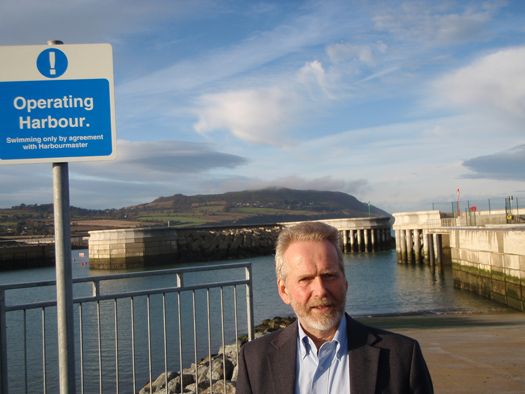
Councillor Derek Mitchell at one of the new slipways now open at Greystones harbour
‘The boat launching facilities are the best in the country and will provide adults and the youth with great sporting opportunities’. The photo shows Cllr Mitchell standing at the top of the new slipway, Mitchell said.
Nama have said they hope to make a decision soon as to whether to fund stage 2 consisting of the Primary Care Centre, five clubhouses and a much better quality finish for the Public Square than at present. The Coastguard and the Council are considering going to tender to construct the Coastguard station. ‘I hope these proceed soon so we can finish the job’ the Councillor added.
All Afloat's Greystones Harbour News here
New Mooring Facilities on River Foyle
Port Harbour master, Bill McCann says this is "positive step forward towards harnessing the potential of the River Foyle for tourism and commerce. The new cruise ship quay at Meadowbank, together with the new pontoon, add significantly to the marine facilities that we offer on the Foyle, which is particularly important with the Clipper Round the World Yacht Race calling at Derry in 2012."

Londonderry Port and Harbour Commissioners sign contract for development of Foyle cruise ship quay and pontoon
Chief executive of the Loughs Agency, Derick Anderson has expressed his enthusiasm for a project "that promises to aid the development of tourism along the Foyle and in the north-west generally, including Inishowen. The new water front infrastructure may reveal fresh opportunities for those planning events in the region, for instance, City of Culture in 2013. The Loughs Agency is optimistic that the project will optimise potential for water based events and activity and help bring the river to life in Londonderry's city centre."
Shaun Henry from the Special EU Programmes Body highlighted the strategic importance of this initiative for the region saying: "This project will allow the local tourism sector to draw on the natural environment of the region and its natural tourism resources. This is likely to attract a higher number of domestic and overseas visitors, contributing to improving the performance of the overall tourism industry, one of the key priorities of the INTERREG IVA Programme. By increasing the offer for high quality marine facilities in the area, it also builds on the strong cultural and economic linkages that exist between western Scotland, Northern Ireland and the west coast of Ireland, where marine tourism is a sector in expansion."
The project is supported by funds from the European Regional Development Fund. The Loughs Agency is lead partner in an Interreg IV programme that secured this funding for some much needed infrastructure. Details about marine leisure on the Foyle on www.loughs-agency.org or www.londonderryport.com
Dun Laoghaire Marina Keeps the Standards High
Dun Laoghaire's superb coastal marina based in the suburbs of Dublin has 820 berths and first opened in 2001. There is plenty to do in Dun Laoghaire with an excellent range of restaurants and bars and not too far to venture into Dublin City.
The management and customer service offered by Dun Laoghaire is excellent with all staff being well trained and very knowledgeable. All facilities are supported at the marina or by neighbouring businesses.

Part of Dun Laoghaire's 820-berth marina, the biggest in Ireland
"The entire team at Dun Laoghaire Marina endeavour at all times to be welcoming and genuinely useful to berth holders and visiting crews." Says Paal Janson CMM, Dun Laoghaire's General Manager. "We take immense pride in our Marina and the service we provide to our customers and this is reflected in the positive comments and feedback we receive throughout the year".
To sum up, this is a well run, professional marina which does everything within its capacity to cater for its berth holders' needs.
The Yacht Harbour Association (TYHA) provides support for marinas and related business throughout the UK and internationally, services include:
The Gold Anchor Award Scheme, which has been operating for 23 years is based on the TYHA Code of Practice for the design construction and operation of marinas. Ratings range from one to five gold anchors. Any award issued is a sure sign of a credible, quality marina with the number of anchors demonstrating the facilities and standard of service available to berth holders and full compliance with statutory regulations.
2011 Port of Cork Cruise Season Draws to a Close
With these high numbers of calls and increasing passenger numbers, the overall economic contribution of the cruise business in Ireland is estimated to be worth €60 million to the island of Ireland. Cork alone contributes an estimated €20m to the local economy both directly and indirectly. In a recent survey carried out by Red C Research on behalf of Cruise Ireland, the look of a port is seen to be a key feature, with those arriving into Cork port citing this as very important in encouraging passengers to disembark and take an excursion. Over 90% of passengers visiting Cork were satisfied with their experience which exceeded their expectations.
Captain Michael McCarthy, Commercial Manager Port of Cork commented on the cruise business saying: 'with so many passengers arriving into Cobh and Cork, the impact this has on the local economy is very positive with the average spend per in-transit passenger approximately €73 per day.'
Continuing Captain McCarthy talked about Cork's potential saying that: 'In 2012 the numbers of calls are already looking very positive with 58 liners expected. As it is the 100th anniversary of the Titanic, Cobh will play an important part in commemorations and already there are three liners booked to call, which are basing their cruise theme around the Titanic.'
Feedback from cruise companies visiting Cork is very positive. Direct access to the quayside for passengers coupled with the accessibility of trains to Cork and the historic town of Cobh and its attractions on their doorstep, makes Cobh an attractive port of call. In 2010 the Port of Cork were awarded 1st place for 'Best Destination Experience (Organised)' in the world and 2nd place for 'Best Port Welcome' at the Dream World Cruise awards. These awards along with Cork being voted within the Lonely Planet's top ten cities to visit must be capitalised.
The Port of Cork has ambitious plans to grow the business to 75 calls over the next five years and already 2012 are experiencing that growth, with 58 liners expected to call. Some of these calls will stay overnight and atleast six liners will make their maiden call to Cork in 2012. This growth is attributed to the Port of Cork's investment of over €8 million to date on berthing facilities, which are the only facilities in Ireland capable of handling the largest liners afloat today.
Wicklow Lifeboat Assists Fishing Vessel after Collision with Tanker
The alarm was raised after the collision took place about 20 miles off the Welsh Coast in the early hours of Monday morning. A volunteer crew from Holyhead RNLI lifeboat Station put to sea along with Wicklow lifeboat.The 3 crew of the beam trawler were uninjured in the incident, but the vessel sustained some damage to fishing gear, but no damage below the waterline. The tanker was able to resume her passage and no damage or pollution was reported.
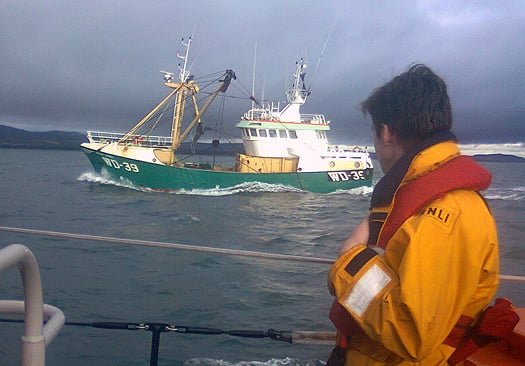
Wicklow RNLI lifeboat escorting the fishing vessel. Photo: RNLI/ Wicklow
The trawler was able to motor back towards the Irish Coast under escort by Holyhead lifeboat. At 07.33hrs Wicklow lifeboat arrived on scene. Holyhead lifeboat was then stood down and returned to station.
Wicklow lifeboat escorted the Beam trawler on the journey back to Wicklow harbour and was safely secured alongside the East pier by 10.30am.
The 3 crew were said to be shaken but uninjured after their ordeal.





























